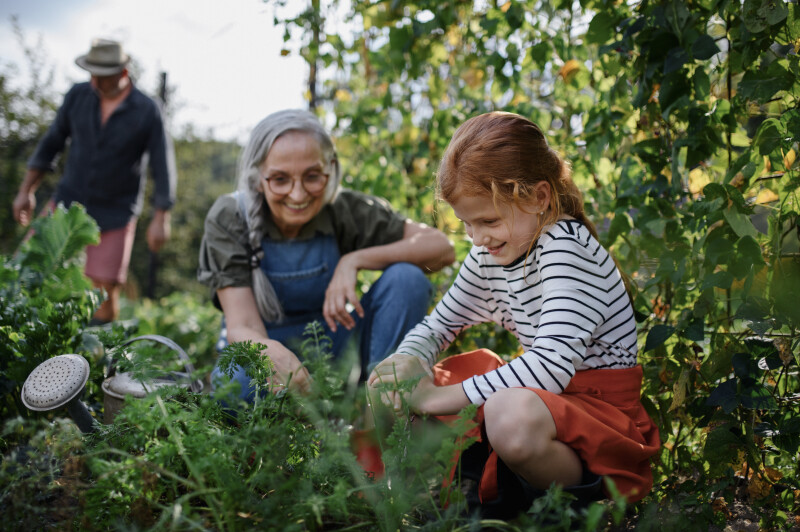There’s an agricultural tradition among some Indigenous peoples called Three Sisters Planting:
“The Iroquois and the Cherokee called corn, bean, and squash ‘the three sisters’ because they nurture each other like family when planted together. [They] placed corn in small hills, planting beans around them and interspersing squash throughout the field. Beans naturally absorb nitrogen from the air and convert it to nitrates, fertilizing the soil for the corn and squash. In return, they are supported by winding around the corn stalks. The squash leaves provide ground cover between the corn and beans, preventing weeds from taking over the field. These three plants thrive together better than when they are planted alone” (USDA).
This symbiotic strategy is genius—one field, a threefold harvest.
On their own, these crops require extensive weeding, fertilization, and fortification. Planted in tandem, the distinctions of each crop help solve the others’ problems.
The Master Gardner, the creative connoisseur of all soils and seeds, knows exactly how to optimize the growth of His crops. He plants each generation into mortality within its season, adding crop after crop.
“One generation passeth away, and another generation cometh: but the earth abideth forever” (Ecclesiastes 1:4).
The soil we share is the same—a mortal experience intended to yield spiritual fruits; a sphere intended to become celestial. The trick, then, is to learn how to grow in fruitful harmony.
Generational Divides
Too often, divides between generations deplete mortality’s soil of its richness. “Millennials are lazy.” “Boomers are out of touch.” “Gen Z is self-absorbed.” “Gen X is cynical.” We hurl these hyperboles back and forth, even in good humor, but deepen our divides in the process.
If we’re on board with the whole Zion idea, dismissiveness toward those who are “too old” or “too young” is especially problematic. The Lord repeats, “I say unto you, be one; and if ye are not one ye are not mine” (Doctrine and Covenants 38:27).
In fact, “Members of the Church should lead out in promoting respect for all of God’s children … rejecting prejudice of any kind. This includes prejudice based on … age.” (Church Handbook 38.6.14)
We know this. But it’s harder to put into practice when your grandpa’s comment at family dinner may have felt socially out of touch. (He’s old, so whatever.) Or when the political stance of your daughter makes you worry that she’s fallen off the deep end. (She did dye her hair, after all.) Or when the joke your grandson made seems to reveal a worrisome worldview. (Kids these days.) Or when the advice from your mother doesn’t feel relevant to your circumstances. (Ugh. Parents.)
Pride will always sabotage unity. Many of these dismissive assumptions stem from a personal belief that “My generation does things right; my generation gets it.” Turning a multigenerational church into Zion will demand that we get off our high horses (or take off our Heelys, as the case may be) and learn how to walk side by side. Prophets have been talking about this for millennia. And the covenant path provides the perfect place to practice.
Covenant Cultivation
I’ve spent the past year puzzling over what could possibly unite the generations of the Church. Over the podium and in Sunday school circles, I’ve seen dismissive attitudes divide Church members old and young. I’ve harbored some age-related prejudice myself. As I studied and mulled over the issue, I was repeatedly led to the same answer: covenants.
The age-old Abrahamic promise is that, through covenant people, all generations should be blessed (Doctrine and Covenants 110:12). Covenants are often described as promises between God and His people, and they are. But as President Emily Belle Freeman recently observed, covenants are so much more than celestial laws and contracts. They are relationships.
Think of the covenants we make when we’re baptized, endowed, and sealed. Within the context of multigenerational relationships, their power becomes blindingly apparent:
Sacrifice. What could teach you more about sacrifice than raising a child?
Obedience. What could teach you more about obedience than being a child?
Chastity. What could prevent heartbreak better than uncompromising fidelity?
The Gospel. Faith, repentance, baptism, the gift of the Holy Ghost, and endurance. How many familial relationships—in direct parallel to those principles—are fortified by trust, second chances, compassion, learning, and continued effort?
Consecration. Where could you better learn to give freely of your time, talents, and energy than in raising and supporting a family?
Through blood relations or community connection, covenant-keeping people understand the importance of relationships. The ordinances and covenants of the gospel are designed to dissolve divides.
As we make and stand by our promises to each other, we learn a whole lot about who God really is. And as we make and keep promises with Him, our interactions with each other are sanctified with depth, intention, and meaning.
Our Sustainers
I used to envision the Lord’s vineyard as a homogenous crop. Now, I see it as an intricate, overlapping system of crops, each meticulously cultivated by a Brilliant Agriculturist who is intent on helping us thrive. The soil churns with seasonal change, but the intention behind His work never changes.
“How great are his signs! and how mighty are his wonders! His kingdom is an everlasting kingdom, and his dominion is from generation to generation” (Daniel 4:3).
This mortal field is ritually replenished with covenant-keeping people, each generation bringing us closer to the eventual promised heaven on Earth. Planted alongside predecessors and posterity, your generation offers specific, complementary strengths to the others.
Perhaps the traditional values of our grandparents are like squash leaves, helping to prevent weeds of deception from sprouting up among pure and simple truths.
Perhaps the resolute guidance of our parents is like a corn stalk, providing stability and strength for our growth, a safe place to call home.
Perhaps the open-mindedness of our children and grandchildren is like the intricate root systems of beans, converting natural elements of diversity into essential nutrients.
“For centuries, many Native American tribes throughout North America have cultivated corn, beans, and squash. These crops were considered to be special gifts from the Great Spirit … collectively called the De-o-ha-ko, meaning ‘our sustainers’ or ‘those who support us’” (USDA).
Our differences are dwarfed by the eternal landscape we share. Instead of thinking of each other as “old” and “young,” we could think of those who have been planted nearby as our sustainers, those who support us—fortifying structures designed to optimize our growth.
Imagine the power of a completely unified, multigenerational people. In emulation of the Son who is one with His Father (John 17:21), we could sprout skyward with such vitality and penetrate the soil with roots so strong that no worldly wind could batter us, no heat could scorch us.
To echo our century-old prophet, who has, quite literally, seen it all, “I am optimistic about the future.” In response to the demands of the day, each generation adopts a gospel perspective that brings us closer to a comprehensively restored celestial society.
The Lord has boundlessly hopeful faith in us. Let’s have a little faith in each other.


